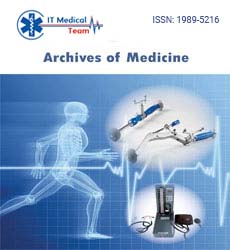Dogan Zeytun*
Department of Internal Medicine, University of Health Sciences, Antalya, Turkey
- *Corresponding Author:
- Dogan Zeytun
Department of Internal Medicine
University of Health Sciences
Antalya, Turkey
E mail: dgzeytun@erincan.edu.tr
Received Date: October 06, 2021; Accepted Date: October 20, 2021; Published Date: October 27, 2021
Citation: Zeytun D (2021) Chronic Thromboembolic Pulmonary Hypertension. Arch Med Vol. 13 No. 10: 50.
The pulmonary circulation is a low-pressure, high-flow circuit that
is well-suited to efficient gas exchange. Pathological events in the
pulmonary circulation can severely disrupt ventilation– perfusion
matching, resulting in increased dead space or raise pulmonary
vascular resistance, exerting additional strain on the right ventricle,
eventually leading to right heart failure. The pathogenesis, clinical
presentation, diagnosis and management of two main illnesses
affecting pulmonary circulation pulmonary thromboembolism and
pulmonary hypertension.
Short Communication
The pulmonary circulation is a low-pressure, high-flow circuit that is well-suited to efficient gas exchange. Pathological events in the pulmonary circulation can severely disrupt ventilation– perfusion matching, resulting in increased dead space, or raise pulmonary vascular resistance, exerting additional strain on the right ventricle, eventually leading to right heart failure. The pathogenesis, clinical presentation, diagnosis, and management of two main illnesses affecting the pulmonary circulationpulmonary thromboembolism and pulmonary hypertension.
To transport blood throughout the body, the lungs and heart must exert pressure. High blood pressure in the arteries of the pulmonary system is known as CTEPH (lungs). Clots in the blood vessels cause this, and they linger for at least three months after taking blood thinners. In most cases, clots leave scar tissue in the arteries.
Anyone can develop chronic thromboembolic pulmonary hypertension. Although CTEPH is caused by pulmonary embolisms (blood clots in the lungs), some persons with CTEPH have never had a PE before.
Risk factors for pulmonary embolisms include:
- Being immobile or inactive for an extended amount of time, such as being bedridden due to illness or not moving enough while travelling by plane or car • Having undergone surgery, particularly a joint replacement
- Growing elderly
- Obesity
- Birth control medications that contain oestrogen
- Smoking
- Suffering from diseases such as cancer
The incidence of CTEPH after symptomatic acute pulmonary embolism has been reported to range from 0.4 percent to 6.2 percent in prospective trials with the diagnosis confirmed by right heart catheterization, yielding a pooled incidence of 3.4 percent (95 percent CI 2.14.4 percent). Since then, a new study from Switzerland evaluated 508 individuals after an acute pulmonary embolism over the course of two years and discovered a cumulative incidence of CTEPH confirmed by RHC of only 0.79 percent.
It's difficult to pinpoint the exact incidence of CTEPH. CTEPH is likely underdiagnosed, and the incidence of CTEPH after an acute pulmonary embolism is likely to be overestimated, making the true incidence difficult to calculate. Under diagnosis is caused by non-specific symptoms, varying rates of antecedent acute pulmonary embolism, and the knowledge necessary to read Computed Tomography Pulmonary Angiography (CTPA). The rare use of lung ventilation/perfusion scintigraphy (V/Q scan) despite guideline guidelines adds to the under diagnosis. In France, over 30 000 acute pulmonary embolism cases are identified each year, with a CTEPH incidence of 3.4 percent. According to Guérin CTEPH affects 4.8 percent of people. Neither of these estimations corresponds to the current prevalence of CTEPH in newly diagnosed patients. An unrecognised mixture of incident and prevalent cases may be a limitation of the various CTEPH incidence reports after acute pulmonary embolism.
Symptoms and perfusion abnormalities are similar in Chronic Thromboembolic Disease (CTED), but there is no PH at rest. The 6th WSPH Task Force on PH diagnosis and classification has recommended a new threshold for PH (mean PAP (mPAP) >20 mmHg) and pre-capillary PH (combination of mPAP >20 mmHg, pulmonary arterial wedge pressure 15 mmHg, and pulmonary vascular resistance (PVR) 3 Wood Units).
For individuals with operable CTEPH, PEA remains the treatment of choice. Two more well-known treatments are now available (i.e. targeted medical therapy and BPA). In the future, specialist centres will need to take a multimodal, individualised approach to therapy, combining surgical, interventional, imaging, and medical PH knowledge with the construction of accurate outcomes studies.
41221






